曼昆经济学原理第三版答案
《经济学原理·曼昆·第三版》第24章
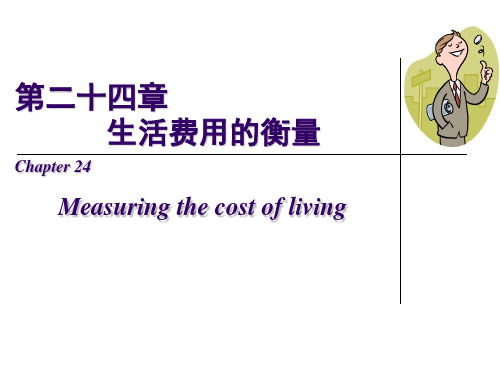
参考资料:美国CPI篮子中有什么?
案例:北京的CPI的计算流程
严格按照国家统计局《流通和消费价格统计调查方 案》的要求:
1. 2. 3. 4. 5.
选择代表规格品。 抽选价格调查点。 计算居民消费价格指数的权数。 价格调查及计算平均价格。 计算居民消费价格指数。
24.1.2 衡量生活费用中的问题 Problems in Measuring The Cost of Living 消费物价指数的目的是衡量生活费用的变动。换句话说,消 费物价指数要确定为了保持生活水平不变,收入应该增加多 少。但是,消费物价指数并不是生活费用的完美衡量指标, 这个指数有三个广泛承认但又难于解决的问题:
上半年 7.9%0日)国家统计局公布了2009年1月份我国居民消费价格 指数和工业品出厂价格指数。统计显示,2009年1月份我国居民消费价 格总水平同比上涨1.0%,1月份工业品出厂价格同比下降3.3%。
24.1.1 如何计算消费者物价指数 How The Consumer Price Index Is Calculated
2005年美元的薪水=1931年美元的薪水×2005年物价/1931年物价 =80000×195/15.2=1026316(美元)
案例:指数先生进入好莱坞
24.2.2 指数化 INDEXATION
正如我们刚刚说明的,当比较不同时期的美元数字时,要用 物价指数来校正通货膨胀的影响。在经济中的许多地方都表 现出这种校正。当某一美元量根据法律或合约自动地按通货 膨胀校正时,这种美元量就称为通货膨胀的指数化。
24.1消费者物价指数 THE CONSUMER PRICE INDEX
消费者物价指数是普通消费者购买的物品与劳务总 费用的衡量指标。在这一部分我们讨论如何计算消 费物价指数,以及在这种衡量中出现了什么问题; 我们还要讨论如何比较消费物价指数与GDP平减指 数。
《经济学原理·曼昆·第三版》第23章
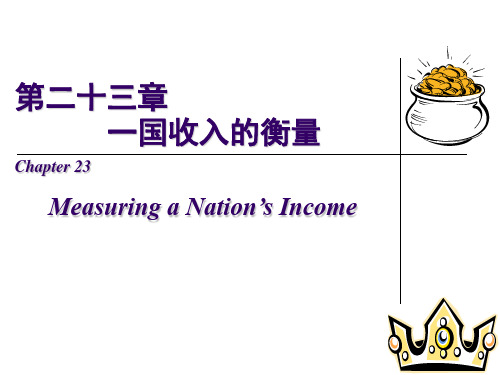
补充:GDP的测算法
现在通常采用三种测算法:生产法,收入法,支出法,
1.生产法:GDP=∑各产业部门的总产出-∑各产业部门的中间 消耗 2.收入法:GDP=∑各产业部门劳动者报酬+∑各产业部门固 定资产折旧+∑各产业部门生产税净额+∑各产业部门营业利 润 或:GDP=工资+利息+利润+租金+间接税+企业转移支付+折 旧+误差
chapter23measuringanationsincomechapter23measuringanationsincome考虑为什么一个经济的总收入等于其总支出考虑为什么一个经济的总收入等于其总支出了解如何定义和计算国内生产总值gdp了解实际考虑gdp了解如何定义和计算国内生产总值了解实际gdp考虑是不是经济福利良好的衡量指标gdpgdp与名义gdp是不是经济福利良好的衡量指标与名义gdpgdp之间的区别之间的区别说明为什么收入等于支出等于产量说明为什么收入等于支出等于产量解释gdp定义消费定义消费投资投资用基期和当年价格计算实际gdp列出许多中并不包括解释gdp定义中的关键词汇和短语政府购买和净出口政府购买和净出口定义中的关键词汇和短语用基期和当年价格计算实际列出许多gdpgdp和名义但能提高福利的活动但能提高福利的活动和名义gdpgdpgdp中并不包括prologueasyoumayrecallfromchapter2economicsisdividedintotwobranches
23.2.1 “GDP是市场价值…” “GDP Is the Market Value . . .”
曼昆经济学原理课后答案第十四章竞争市场上的企业
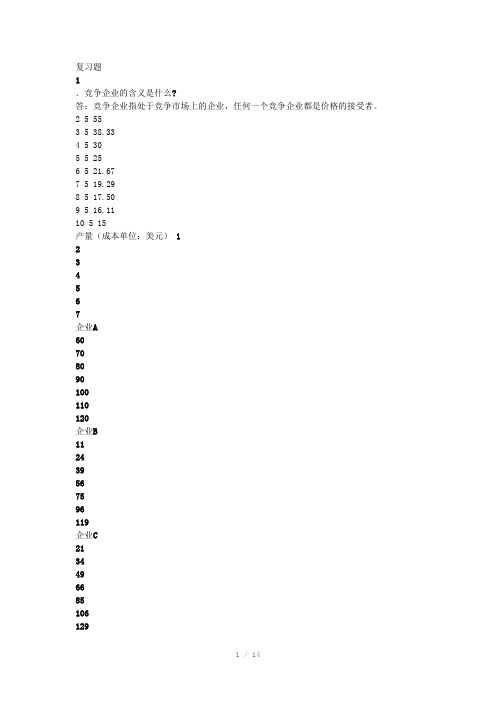
复习题1.竞争企业的含义是什么?答:竞争企业指处于竞争市场上的企业,任何一个竞争企业都是价格的接受者。
2 5 553 5 38.334 5 305 5 256 5 21.677 5 19.298 5 17.509 5 16.1110 5 15产量(成本单位:美元)1234567企业A60708090100110120企业B112439567596119企业C2134496685106129产量(成本单位:美元) 1 2 3 4 5 6 7企业A 60 35 27 22.5 20 18 17企业B 11 12 13 14 15 16 17企业C 21 17 16 16.5 17 18 18.4812.解释企业收益与企业利润的差别。
企业使什么最大化?答:企业的总收益等于单位销售数量乘以其价格,即企业销售其产品所得到的货币量。
企业利润是总收益和总成本的差额。
企业使利润最大化。
3.画出一个典型企业的成本曲线。
解释在某一既定价格时,企业应如何选择利润最大化的产量水平。
在该产量水平时,在你的图形中标明企业的总收益及总成本答:竞争企业在某一既定价格时,利润最大化的产量水平Q 是在边际成本曲线和价格水平曲线的相交之处。
因为如果企业选择产量Q1,Q1<Q,MC<MR,即企业增加一单位产量所带来的边际收益大于边际成本。
于是,企业会增加产量以提高利润。
如果企业选择产量Q2(Q2>Q),MC>MR,即企业再增加一单位产量所带来的边际收益小于边际成本。
于是,企业可以通过减少产量以提高利润。
图14-1 典型企业的成本曲线4.在什么条件下企业将暂停营业?解释原因。
答:如果物品的价格低于生产的平均成本,企业选择停止营业。
在短期内,固定成本是沉没成本,在此决策中不考虑。
作出这一决策的原因很简单:在选择生产时,企业比较普通一单位产量所得到的价格与生产这一单位必定引起的平均可变成本。
如果价格没有弥补平均可变成本,企业停止生产,状况会变好一些。
曼昆经济学原理试题及答案

曼昆经济学原理试题及答案一、名词解释(每小题 5 分,共 50 分)机会成本科斯定理搭便车囚徒困境菲利普斯曲线供给侧凯恩斯革命看不见的手比较优势外部性二、简述题(第 11、12、13 题各 12 分, 14 题 14 分,共 50 分)1.简要描述银行存款的创建过程。
2.简述失业的根源及其类型。
3.简要描述节俭的对与错。
4.根据有关经济学原理,简析我国森林减少、珍稀动物来绝的原因及解决的措施。
三、论述题(每小题 25 分,共计 50 分)1.讨论人民币升值对中国经济的影响。
2.论述政府公共投资对国民经济的作用。
一、名词解释(每一个子话题 5 分,共 50 分)1.机会成本:指人们利用一定资源获得某种收入时所抛却的在其他可能的用途中所能够获取的最大收入。
生产一单位的某种商品的机会成本是指生产者所抛却的使用相同的生产要素在其他生产用途中所能得到的最高收入。
机会成本的存在需要三个前提条件。
第一,资源是稀缺的;第二,资源具有多种生产用途;第三,资源的投无限制访问。
在从机会成本的角度审视生产过程时,创造商需要将生产要素投入到效益最大的项目中,以避免生产浪费,实现资源的最优配置。
机会成本的概念是基于资源的稀缺性。
在经济资源稀缺的前提下,当一个社会或者企业利用一定的经济资源生产一定数量的一种或者几种产品时,这些经济资源不能同时用于其他生产用途。
也就是说,这个社会或者这个企业能够获得的一定数量的产品收入,是以抛却利用同样的经济资源生产其他产品所能获得的收入为代价的。
这也是机会成本的原因。
因此,一个社会生产一种产品的实际成本是它不能生产其他产品的成本。
因此,机会成本的含义是,任何生产资源或者生产要素一般都有各种不同的方式或者机会,也就是说,它可以用于生产各种产品。
然而,当一定数量的特定资源用于生产 a 类产品时,它们不能同时用于生产 B 类产品。
因此,生产一种产品的实际成本是不生产 B 产品的成本,或者等于这种资源生产 B 产品可能获得的最大回报。
经济学原理第三版习题答案

SOLUTIONS TO TEXT PROBLEMS:Quick Quizzes1. Figure 1 shows the supply and demand curves for cookies, with equilibrium quantity Q1 andequilibrium price P1. When the government imposes a tax on cookies, the price to buyers rises to P B, the price received by sellers declines to P S, and the equilibrium quantity falls to Q2. Thedeadweight loss is the triangular area below the demand curve and above the supply curvebetween quantities Q1 and Q2. The deadweight loss shows the fall in total surplus that resultsfrom the tax.Figure 12. A tax on beer would have a larger deadweight loss than a tax on milk, since the demand for beer ismore elastic than the demand for milk and the deadweight loss of a tax is larger the greater is the elasticity of demand.3. If the government doubles the tax on gasoline, the revenue from the gasoline tax could rise or fall,depending on where the tax falls on the Laffer curve. However, if the government doubles the tax on gasoline, you can be sure that the deadweight loss of the tax rises, since deadweight loss always rises as the tax rate rises.Questions for Review1. When the sale of a good is taxed, both consumer surplus and producer surplus decline. Thedecline in consumer surplus and producer surplus exceeds the amount of government revenue that is raised, so society's total surplus declines. The tax distorts the incentives of both buyers andsellers, so resources are allocated inefficiently.2. Figure 2 illustrates the deadweight loss and tax revenue from a tax on the sale of a good. Withouta tax, the equilibrium quantity would be Q1, the equilibrium price would be P1, consumer surpluswould be A+B+C, and producer surplus would be D+E+F. The imposition of a tax places a wedge between the price buyers pay, P B, and the price sellers receive, P S, where P B = P S + tax. Thequantity sold declines to Q2. Now consumer surplus is A, producer surplus is F, and government revenue is B+D. The deadweight loss of the tax is C+E, since that area is lost because of thedecline in quantity from Q1 to Q2.Figure 23. The greater the elasticities of demand and supply, the greater the deadweight loss of a tax. Sinceelasticity measures the response of quantity to a change in price, higher elasticity means the tax induces a greater reduction in quantity, hence a greater distortion to the market.4. Experts disagree about whether labor taxes have small or large deadweight losses because theyhave different views about the elasticity of labor supply. Some believe that labor supply isinelastic, so a tax on labor has a small deadweight loss. But others think that workers can adjust their hours worked in various ways, so labor supply is elastic, and thus a tax on labor has a large deadweight loss.5. The deadweight loss of a tax rises more than proportionally as the tax rises. Tax revenue,however, may increase initially as the tax rises, but as the tax rises further, revenue eventuallydeclines.Problems and Applications1. a. Figure 3 illustrates the market for pizza. The equilibrium price is P1, the equilibriumquantity is Q1, consumer surplus is area A+B+C, and producer surplus is area D+E+F.There is no deadweight loss, as all the potential gains from trade are realized; total surplusis the entire area between the demand and supply curves A+B+C+D+E+F.Figure 3b. With a $1 tax on each pizza sold, the price paid by buyers, P B, is now higher than the pricereceived by sellers, P S, where P B = P S + $1. The quantity declines to Q2, consumersurplus is area A, producer surplus is area F, government revenue is area B+D, anddeadweight loss is area C+E. Consumer surplus declines by B+C, producer surplusdeclines by D+E, government revenue increases by B+D, and deadweight loss increasesby C+E.c. If the tax were removed and consumers and producers voluntarily transferred B+D to thegovernment to make up for the lost tax revenue, then everyone would be better off thanwithout the tax. The equilibrium quantity would be Q1, as in the case without the tax, andthe equilibrium price would be P1. Consumer surplus would be A+C, because consumersget surplus of A+B+C, then voluntarily transfer B to the government. Producer surpluswould be E+F, since producers get surplus of D+E+F, then voluntarily transfer D to thegovernment. Both consumers and producers are better off than the case when the taxwas imposed. If consumers and producers gave a little bit more than B+D to thegovernment, then all three parties, including the government, would be better off. Thisillustrates the inefficiency of taxation.2. a. The statement, "If the government taxes land, wealthy landowners will pass the tax on totheir poorer renters," is incorrect. With a tax on land, landowners can not pass the tax on.Since the supply curve of land is perfectly inelastic, landowners bear the entire burden ofthe tax. Renters will not be affected at all.b. The statement, "If the government taxes apartment buildings, wealthy landowners willpass the tax on to their poorer renters," is partially correct. With a tax on apartmentbuildings, landowners can pass the tax on more easily, though the extent to which they dothis depends on the elasticities of supply and demand. In this case, the tax is a directaddition to the cost of rental units, so the supply curve will shift up by the amount of thetax. The tax will be shared by renters and landowners, depending on the elasticities ofdemand and supply.3. a. The statement, "A tax that has no deadweight loss cannot raise any revenue for thegovernment," is incorrect. An example is the case of a tax when either supply or demandis perfectly inelastic. The tax has neither an effect on quantity nor any deadweight loss,but it does raise revenue.b. The statement, "A tax that raises no revenue for the government cannot have anydeadweight loss," is incorrect. An example is the case of a 100 percent tax imposed onsellers. With a 100 percent tax on their sales of the good, sellers won't supply any of thegood, so the tax will raise no revenue. Yet the tax has a large deadweight loss, since itreduces the quantity sold to zero.4. a. With very elastic supply and very inelastic demand, the burden of the tax on rubber bandswill be borne largely by buyers. As Figure 4 shows, consumer surplus declinesconsiderably, by area A+B, but producer surplus doesn't fall much at all, just by area C+D.Figure 4b. With very inelastic supply and very elastic demand, the burden of the tax on rubber bandswill be borne largely by sellers. As Figure 5 shows, consumer surplus does not declinemuch, just by area A+B, while producer surplus falls substantially, by area C+D.Compared to part (a), producers bear much more of the burden of the tax, and consumersbear much less.Figure 55. a. The deadweight loss from a tax on heating oil is likely to be greater in the fifth year after it is imposed rather than the first year. In the first year, the elasticity of demand is fairlylow, as people who own oil heaters are not likely to get rid of them right away. But overtime they may switch to other energy sources and people buying new heaters for theirhomes will more likely choose gas or electric, so the tax will have a greater impact onquantity.b. The tax revenue is likely to be higher in the first year after it is imposed than in the fifthyear. In the first year, demand is more inelastic, so the quantity does not decline as muchand tax revenue is relatively high. As time passes and more people substitute away fromoil, the equilibrium quantity declines, as does tax revenue.6. Since the demand for food is inelastic, a tax on food is a good way to raise revenue because it doesnot lead to much of a deadweight loss; thus taxing food is less inefficient than taxing other things.But it is not a good way to raise revenue from an equity point of view, since poorer people spend a higher proportion of their income on food, so the tax would hit them harder than it would hitwealthier people.7. a. This tax has such a high rate that it is not likely to raise much revenue. Because of thehigh tax rate, the equilibrium quantity in the market is likely to be at or near zero.b. Senator Moynihan's goal was probably to ban the use of hollow-tipped bullets. In thiscase, a tax is as effective as an outright ban.8. a. Figure 6 illustrates the market for socks and the effects of the tax. Without a tax, theequilibrium quantity would be Q1, the equilibrium price would be P1, total spending byconsumers equals total revenue for producers, which is P1 x Q1, which equals areaB+C+D+E+F, and government revenue is zero. The imposition of a tax places a wedgebetween the price buyers pay, P B, and the price sellers receive, P S, where P B = P S + tax.The quantity sold declines to Q2. Now total spending by consumers is P B x Q2, whichequals area A+B+C+D, total revenue for producers is P S x Q2, which is area C+D, andgovernment tax revenue is Q2 x tax, which is area A+B.b. Unless supply is perfectly elastic, the price received by producers falls because of the tax.Total receipts for producers fall, since producers lose revenue equal to area B+E+F.Figure 6c. The price paid by consumers rises, unless demand is perfectly elastic. Whether totalspending by consumers rises or falls depends on the price elasticity of demand. Ifdemand is elastic, the percentage decline in quantity exceeds the percentage increase inprice, so total spending declines. If demand is inelastic, the percentage decline inquantity is less than the percentage increase in price, so total spending rises. Whethertotal consumer spending falls or rises, consumer surplus declines because of the increasein price and reduction in quantity.9. Since the tax on gadgets was eliminated, all tax revenue must come from the tax on widgets. Thetax revenue from the tax on widgets equals the tax per unit times the quantity produced.Assuming that neither the supply nor the demand curves for widgets are perfectly elastic orinelastic and since the increased tax causes a smaller quantity of widgets to be produced, then it is impossible for tax revenue to double--multiplying the tax per unit (which doubles) times thequantity (which declines) gives a number that is less than double the original tax revenue fromwidgets. So the government's tax change will yield less money than before.10. a. Figure 7 illustrates the effects of the tax increase on the new car market in New Jersey.The quantity of cars sold declines from Q1 to Q2, the price paid by consumers rises from P B1to P B2, and the price received by producers declines from P S1 to P S2, where P B1 = P S1 +$100 and P B2 = P S2 + $150.Figure 7d. The change in deadweight loss is positive, as it increases by C+E+G, meaning that theeconomy as a whole is worse off.e. The demand for cars in New Jersey is probably fairly elastic, since people could travel tonearby states to buy cars. With elastic demand, area B in the figure will be very small, sothe additional tax is less likely to increase government revenue. New Jersey could try toreduce the elasticity of demand by requiring people to pay sales tax to New Jersey whenthey buy a car outside the state.11. From the standpoint of economic efficiency, the British poll tax is wonderful, because it does notdistort any economic incentives, so it has no deadweight loss. But such a tax is inequitable,because it is more burdensome on the poor than on the rich. As a result, the tax was quiteunpopular.12. Figure 8 illustrates the effects of the $2 subsidy on a good. Without the subsidy, the equilibriumprice is P1 and the equilibrium quantity is Q1. With the subsidy, buyers pay price P B, producers receive price P S (where P S = P B + $2), and the quantity sold is Q2. The following table illustrates the effect of the subsidy on consumer surplus, producer surplus, government revenue, and total surplus. Since total surplus declines by area D+H, the subsidy leads to a deadweight loss in that13. a. Setting quantity supplied equal to quantity demanded gives 2P = 300 –P. Adding P toboth sides of the equation gives 3P = 300. Dividing both sides by 3 gives P = 100.Plugging P = 100 back into either equation for quantity demanded or supplied gives Q =200.b. Now P is the price received by sellers and P+T is the price paid by buyers. Equatingquantity demanded to quantity supplied gives 2P = 300 - (P+T). Adding P to both sidesof the equation gives 3P = 300 –T. Dividing both sides by 3 gives P = 100 - T/3. This isthe price received by sellers. The buyers pay a price equal to the price received by sellersplus the tax (P+T = 100 + 2T/3). The quantity sold is now Q = 2P = 200 – 2T/3.c. Since tax revenue is equal to T x Q and Q = 200 - 2T/3, tax revenue equals200T - 2T2/3. Figure 9 shows a graph of this relationship. Tax revenue is zero at T = 0and at T = 300.Figure 9d. As Figure 10 shows, the area of the triangle (laid on its side) that represents thedeadweight loss is 1/2 x base x height, where the base is the change in the price, which isthe size of the tax (T) and the height is the amount of the decline in quantity (2T/3). Sothe deadweight loss equals 1/2 x T x 2T/3 = T2/3. This rises exponentially from 0 (whenT = 0) to 45,000 when T = 300, as shown in Figure 11.Figure 10Figure 11e. A tax of $200 per unit is a bad idea, because it's in a region in which tax revenue isdeclining. The government could reduce the tax to $150 per unit, get more tax revenue($15,000 when the tax is $150 versus $13,333 when the tax is $200), and reduce thedeadweight loss (7,500 when the tax is $150 compared to 13,333 when the tax is $200).。
曼昆经济学习题解答

曼昆经济学习题解答Ch5 经济增长2⼀、名词解释劳动效率劳动扩⼤型技术进步内⽣增长理论⼆、选择题1.在有⼈⼝增长和技术进步的索洛模型中,稳定状态时每个效率⼯⼈的产出增长率等于:()A.0 B.技术增长率gC.⼈⼝增长率n+技术增长率g D.储蓄率s2.在有⼈⼝增长和技术进步的索洛模型中,稳定状态时每个⼯⼈的产出增长率等于:()A.0 B.技术增长率gC.⼈⼝增长率n+技术增长率g D.储蓄率s3.在⼈⼝增长⽐率为n和劳动扩⼤型技术进步⽐率为g的索洛模型中,每个效率⼯⼈的资本存量变化等于:()A.sf(k) + (d + n + g)k B.sf(k) + (d - n - g)kC.sf(k) - (d + n + g)k D.sf(k) - (d - n - g)k4.下列可以⿎励技术进步的是()A.新产品实⾏专利制度B.对研发的税收激励C.对研发的政府补贴D.以上都是5.索洛模型表明⾼⼈⼝增长率的国家将会有():A.较低的稳定状态⼈均产出⽔平B.较低的稳定状态⼈均产出增长率C.A和B D.较⾼的稳定状态⼈均产出增长率三、问答题1.政府政策为医学研究提供资⾦是⼀个经常被争论的问题。
a.运⽤外部性,社会收益和私⼈收益的概念,讨论政府为什么应该或者不应该为医学研究提供资⾦。
政府怎样才能⿎励私营公司增加研究开⽀?b.如果政府觉得需要对医学研究投⼊更⼤的资⾦,你认为政府是直接投资研究项⽬还是对投资这些研究私营公司采⽤激励政策更好?你认为这两个计划分别会对药品⽣产所产⽣的费⽤发⽣怎样的影响?2.⽐较两部门内⽣增长模型和索洛模型。
两个模型的相同之处是什么?两个模型的假设有不同?你觉得哪个更实际?请解释。
3.在索洛模型中,谈谈技术进步、资本存量的增长、⼈⼝的增长对稳定状态的⼈均收⼊增长率的影响?4.为了确定⼀个经济的资本⼤于还是⼩于黄⾦规则稳定状态,你需要什么数据?5.决策者可以如何影响⼀国的储蓄率?6.过去40年间⽣产率的增长率发⽣了什么变动?你如何解释这种现象、7.内⽣增长理论如何在没有外⽣技术进步的假设的情况下解释长期增长?这种解释与索洛模型有什么不同?8.证明下列有关⼈⼝增长与技术进步时稳定状态的每⼀种表述。
曼昆经济学原理课后答案第十三章生产成本
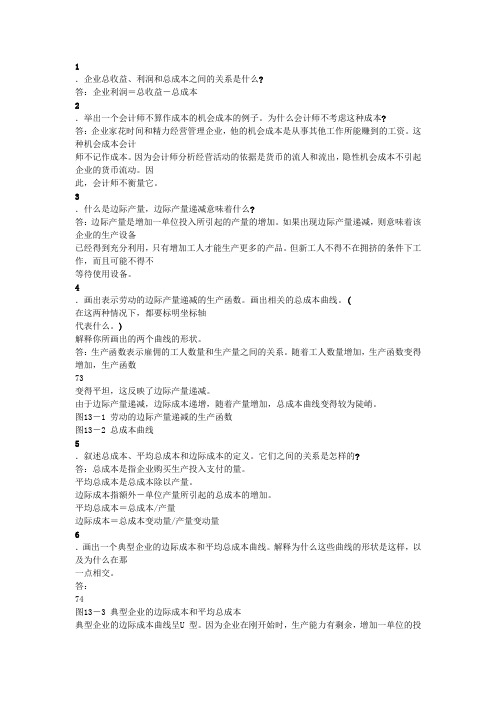
1.企业总收益、利润和总成本之间的关系是什么?答:企业利润=总收益-总成本2.举出一个会计师不算作成本的机会成本的例子。
为什么会计师不考虑这种成本?答:企业家花时间和精力经营管理企业,他的机会成本是从事其他工作所能赚到的工资。
这种机会成本会计师不记作成本。
因为会计师分析经营活动的依据是货币的流人和流出,隐性机会成本不引起企业的货币流动。
因此,会计师不衡量它。
3.什么是边际产量,边际产量递减意味着什么?答:边际产量是增加一单位投入所引起的产量的增加。
如果出现边际产量递减,则意味着该企业的生产设备已经得到充分利用,只有增加工人才能生产更多的产品。
但新工人不得不在拥挤的条件下工作,而且可能不得不等待使用设备。
4.画出表示劳动的边际产量递减的生产函数。
画出相关的总成本曲线。
(在这两种情况下,都要标明坐标轴代表什么。
)解释你所画出的两个曲线的形状。
答:生产函数表示雇佣的工人数量和生产量之间的关系。
随着工人数量增加,生产函数变得增加,生产函数73变得平坦,这反映了边际产量递减。
由于边际产量递减,边际成本递增,随着产量增加,总成本曲线变得较为陡峭。
图13-1 劳动的边际产量递减的生产函数图13-2 总成本曲线5.叙述总成本、平均总成本和边际成本的定义。
它们之间的关系是怎样的?答:总成本是指企业购买生产投入支付的量。
平均总成本是总成本除以产量。
边际成本指额外-单位产量所引起的总成本的增加。
平均总成本=总成本/产量边际成本=总成本变动量/产量变动量6.画出一个典型企业的边际成本和平均总成本曲线。
解释为什么这些曲线的形状是这样,以及为什么在那一点相交。
答:74图13-3 典型企业的边际成本和平均总成本典型企业的边际成本曲线呈U 型。
因为企业在刚开始时,生产能力有剩余,增加一单位的投入量,边际产量会高于前一单位的投入,这样就出现一段边际成本下降。
生产能力全部被利用之后,再增加边际投入,就会出现边际产量递减,边际成本递增。
(完整版)曼昆宏观经济学原理答案
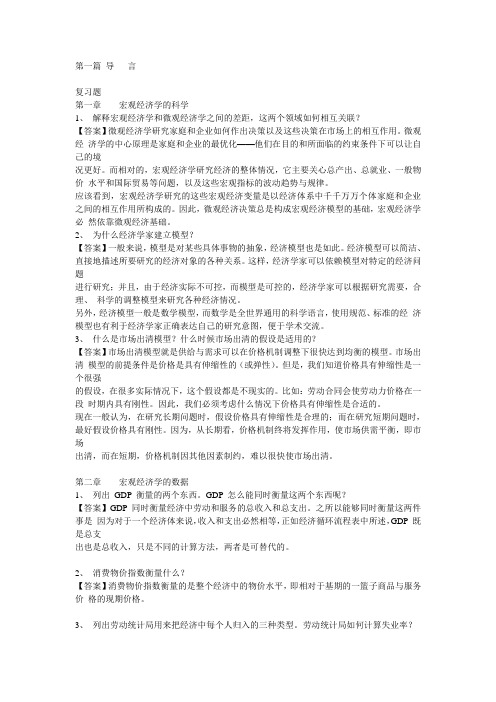
第一篇导言复习题第一章宏观经济学的科学1、解释宏观经济学和微观经济学之间的差距,这两个领域如何相互关联?【答案】微观经济学研究家庭和企业如何作出决策以及这些决策在市场上的相互作用。
微观经济学的中心原理是家庭和企业的最优化——他们在目的和所面临的约束条件下可以让自己的境况更好。
而相对的,宏观经济学研究经济的整体情况,它主要关心总产出、总就业、一般物价水平和国际贸易等问题,以及这些宏观指标的波动趋势与规律。
应该看到,宏观经济学研究的这些宏观经济变量是以经济体系中千千万万个体家庭和企业之间的相互作用所构成的。
因此,微观经济决策总是构成宏观经济模型的基础,宏观经济学必然依靠微观经济基础。
2、为什么经济学家建立模型?【答案】一般来说,模型是对某些具体事物的抽象,经济模型也是如此。
经济模型可以简洁、直接地描述所要研究的经济对象的各种关系。
这样,经济学家可以依赖模型对特定的经济问题进行研究;并且,由于经济实际不可控,而模型是可控的,经济学家可以根据研究需要,合理、科学的调整模型来研究各种经济情况。
另外,经济模型一般是数学模型,而数学是全世界通用的科学语言,使用规范、标准的经济模型也有利于经济学家正确表达自己的研究意图,便于学术交流。
3、什么是市场出清模型?什么时候市场出清的假设是适用的?【答案】市场出清模型就是供给与需求可以在价格机制调整下很快达到均衡的模型。
市场出清模型的前提条件是价格是具有伸缩性的(或弹性)。
但是,我们知道价格具有伸缩性是一个很强的假设,在很多实际情况下,这个假设都是不现实的。
比如:劳动合同会使劳动力价格在一段时期内具有刚性。
因此,我们必须考虑什么情况下价格具有伸缩性是合适的。
现在一般认为,在研究长期问题时,假设价格具有伸缩性是合理的;而在研究短期问题时,最好假设价格具有刚性。
因为,从长期看,价格机制终将发挥作用,使市场供需平衡,即市场出清,而在短期,价格机制因其他因素制约,难以很快使市场出清。
(完整版)曼昆宏观经济学原理答案

第一篇导言复习题第一章宏观经济学的科学1、解释宏观经济学和微观经济学之间的差距,这两个领域如何相互关联?【答案】微观经济学研究家庭和企业如何作出决策以及这些决策在市场上的相互作用。
微观经济学的中心原理是家庭和企业的最优化——他们在目的和所面临的约束条件下可以让自己的境况更好。
而相对的,宏观经济学研究经济的整体情况,它主要关心总产出、总就业、一般物价水平和国际贸易等问题,以及这些宏观指标的波动趋势与规律。
应该看到,宏观经济学研究的这些宏观经济变量是以经济体系中千千万万个体家庭和企业之间的相互作用所构成的。
因此,微观经济决策总是构成宏观经济模型的基础,宏观经济学必然依靠微观经济基础。
2、为什么经济学家建立模型?【答案】一般来说,模型是对某些具体事物的抽象,经济模型也是如此。
经济模型可以简洁、直接地描述所要研究的经济对象的各种关系。
这样,经济学家可以依赖模型对特定的经济问题进行研究;并且,由于经济实际不可控,而模型是可控的,经济学家可以根据研究需要,合理、科学的调整模型来研究各种经济情况。
另外,经济模型一般是数学模型,而数学是全世界通用的科学语言,使用规范、标准的经济模型也有利于经济学家正确表达自己的研究意图,便于学术交流。
3、什么是市场出清模型?什么时候市场出清的假设是适用的?【答案】市场出清模型就是供给与需求可以在价格机制调整下很快达到均衡的模型。
市场出清模型的前提条件是价格是具有伸缩性的(或弹性)。
但是,我们知道价格具有伸缩性是一个很强的假设,在很多实际情况下,这个假设都是不现实的。
比如:劳动合同会使劳动力价格在一段时期内具有刚性。
因此,我们必须考虑什么情况下价格具有伸缩性是合适的。
现在一般认为,在研究长期问题时,假设价格具有伸缩性是合理的;而在研究短期问题时,最好假设价格具有刚性。
因为,从长期看,价格机制终将发挥作用,使市场供需平衡,即市场出清,而在短期,价格机制因其他因素制约,难以很快使市场出清。
曼昆 经济学原理 第三版 答案 第1篇

第一篇导言第一章经济学十大原理1.列举三个你在生活中面临的重要权衡取合的例子。
答:①大学毕业后.面临着是否继续深造的选择,选择继续上学攻读研究生学位,就意味着在今后三年中放弃参加工作、赚工资和积累社会经验的机会;2、在学习内容上也面临着很重要的权衡取舍,如果学习《经济学》,就要减少学习英语或其他专业课的时间,③对于不多的生活费的分配同样面临权衡取舍,要多买书.就要减少在吃饭、买衣服等其他方面的开支。
2、看一场电影的机会成本是什么?答:看一场电影的机会成本是在看电影的时间里做其他事情所能获得的最大收益,例如:看书、打零工。
3、水是生活必需的。
一杯水的边际利益是大还是小呢?答:这要看这杯水是在什么样的情况下喝.如果这是一个人五分钟内喝下的第五杯水.那么他的边际利益很小.有可能为负;如果这是一个极度干渴的人喝下的第一杯水,那么他的边际利益将会极大。
4、为什么决策者应该考虑激励?答:因为人们会对激励做出反应。
如果政策改变了激励,它将使人们改变自己的行为,当决策者未能考虑到行为如何由于政策的原因而变化时.他们的政策往往会产生意想不到的效果。
5 为什么各国之间的贸易不像竞赛一样有赢家和输家呢?答:因为贸易使各国可以专门从事自己最擅长的话动,并从中享有更多的各种各样的物品与劳务。
通过贸易使每个国家可供消费的物质财富增加,经济状况变得更好。
因此,各个贸易国之间既是竞争对手,又是经济合作伙伴。
在公平的贸易中是“双赢”或者“多赢”的结果。
6.市场巾的那只“看不见的手”在做什么呢,答:市场中那只“看不见的手”就是商品价格,价格反映商品自身的价值和社会成本,市场中的企业和家庭在作出买卖决策时都要关注价格。
因此.他们也会不自觉地考虑自己行为的(社会)收益和成本。
从而,这只“看不见的手”指引着干百万个体决策者在大多数情况下使社会福利趋向最大化。
7 解释市场失灵的两个主要原因,并各举出一个例子。
答:市场失灵的主要原因是外部性和市场势力。
曼昆微观经济学(第三版)课后习题答案
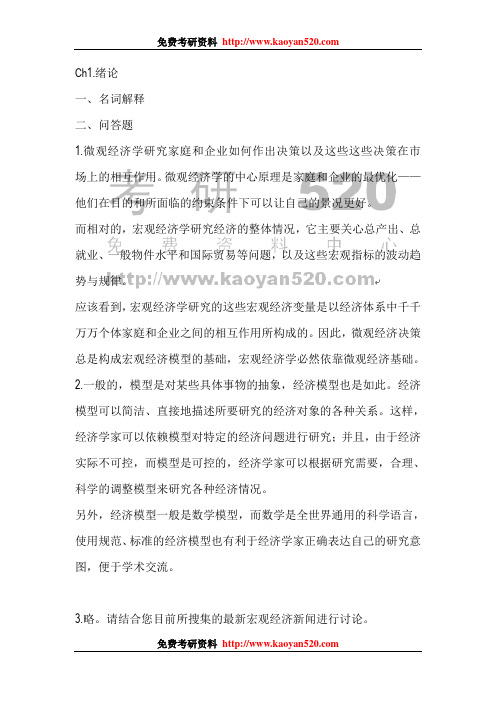
Ch1.绪论一、名词解释二、问答题1.微观经济学研究家庭和企业如何作出决策以及这些这些决策在市场上的相互作用。
微观经济学的中心原理是家庭和企业的最优化——他们在目的和所面临的约束条件下可以让自己的景况更好。
而相对的,宏观经济学研究经济的整体情况,它主要关心总产出、总就业、一般物件水平和国际贸易等问题,以及这些宏观指标的波动趋势与规律。
应该看到,宏观经济学研究的这些宏观经济变量是以经济体系中千千万万个体家庭和企业之间的相互作用所构成的。
因此,微观经济决策总是构成宏观经济模型的基础,宏观经济学必然依靠微观经济基础。
2.一般的,模型是对某些具体事物的抽象,经济模型也是如此。
经济模型可以简洁、直接地描述所要研究的经济对象的各种关系。
这样,经济学家可以依赖模型对特定的经济问题进行研究;并且,由于经济实际不可控,而模型是可控的,经济学家可以根据研究需要,合理、科学的调整模型来研究各种经济情况。
另外,经济模型一般是数学模型,而数学是全世界通用的科学语言,使用规范、标准的经济模型也有利于经济学家正确表达自己的研究意图,便于学术交流。
3.略。
请结合您目前所搜集的最新宏观经济新闻进行讨论。
4.市场出清模型就是供给与需求可以在价格机制调整下很快达到均衡的模型。
市场出清模型的前提条件是价格是具有伸缩性的(或弹性)。
但是,我们知道,价格具有伸缩性是一个很强的假设,在很多实际情况下,这个假设都是不现实的。
比如:劳动合同会使劳动力价格在一段时期内具有刚性。
因此,我们必须考虑什么情况下价格具有伸缩性是合适的。
现在一般地认为,在研究长期问题时,假设价格具有伸缩性是合理的;而在研究短期问题时,最好假设价格具有刚性。
因为,从长期看,价格机制终将发挥作用,使市场供需平衡,即市场出清,而在短期,价格机制因其他因素制约,难以很快使市场出清。
5.一般的,人们认为科学的定义是:一种建立稳定关系的科学的研究方法。
比如:物理学家可以通过实验来收集数据,证明或推翻一个假设。
曼昆《经济学原理(微观经济学分册)》课后习题详解(第1篇)
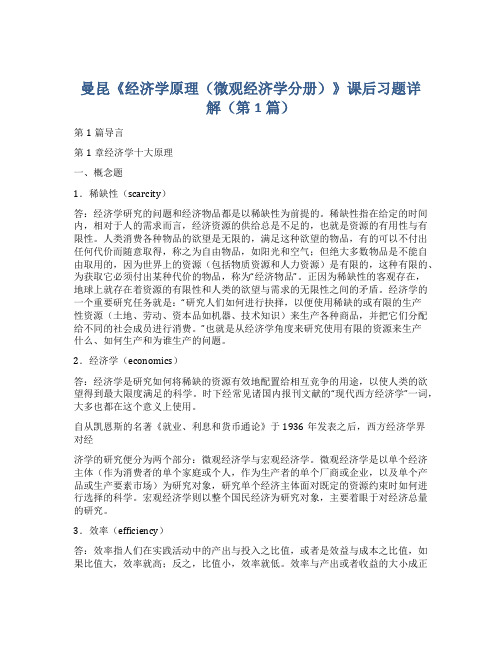
曼昆《经济学原理(微观经济学分册)》课后习题详解(第1篇)第1篇导言第1章经济学十大原理一、概念题1.稀缺性(scarcity)答:经济学研究的问题和经济物品都是以稀缺性为前提的。
稀缺性指在给定的时间内,相对于人的需求而言,经济资源的供给总是不足的,也就是资源的有用性与有限性。
人类消费各种物品的欲望是无限的,满足这种欲望的物品,有的可以不付出任何代价而随意取得,称之为自由物品,如阳光和空气;但绝大多数物品是不能自由取用的,因为世界上的资源(包括物质资源和人力资源)是有限的,这种有限的、为获取它必须付出某种代价的物品,称为“经济物品”。
正因为稀缺性的客观存在,地球上就存在着资源的有限性和人类的欲望与需求的无限性之间的矛盾。
经济学的一个重要研究任务就是:“研究人们如何进行抉择,以便使用稀缺的或有限的生产性资源(土地、劳动、资本品如机器、技术知识)来生产各种商品,并把它们分配给不同的社会成员进行消费。
”也就是从经济学角度来研究使用有限的资源来生产什么、如何生产和为谁生产的问题。
2.经济学(economics)答:经济学是研究如何将稀缺的资源有效地配置给相互竞争的用途,以使人类的欲望得到最大限度满足的科学。
时下经常见诸国内报刊文献的“现代西方经济学”一词,大多也都在这个意义上使用。
自从凯恩斯的名著《就业、利息和货币通论》于1936年发表之后,西方经济学界对经济学的研究便分为两个部分:微观经济学与宏观经济学。
微观经济学是以单个经济主体(作为消费者的单个家庭或个人,作为生产者的单个厂商或企业,以及单个产品或生产要素市场)为研究对象,研究单个经济主体面对既定的资源约束时如何进行选择的科学。
宏观经济学则以整个国民经济为研究对象,主要着眼于对经济总量的研究。
3.效率(efficiency)答:效率指人们在实践活动中的产出与投入之比值,或者是效益与成本之比值,如果比值大,效率就高;反之,比值小,效率就低。
效率与产出或者收益的大小成正比,而与成本或投入成反比,也就是说,如果想提高效率,必须降低成本或投入,提高收益或产出。
曼昆经济学习题解答
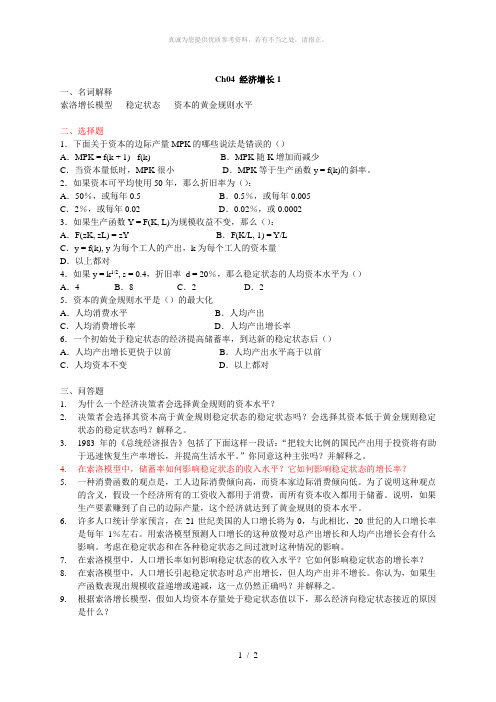
Ch04 经济增长1一、名词解释索洛增长模型稳定状态资本的黄金规则水平二、选择题1.下面关于资本的边际产量MPK的哪些说法是错误的()A.MPK = f(k + 1) - f(k) B.MPK随K增加而减少C.当资本量低时,MPK很小D.MPK等于生产函数y = f(k)的斜率。
2.如果资本可平均使用50年,那么折旧率为():A.50%,或每年0.5 B.0.5%,或每年0.005C.2%,或每年0.02 D.0.02%,或0.00023.如果生产函数Y = F(K, L)为规模收益不变,那么():A.F(zK, zL) = zY B.F(K/L, 1) = Y/LC.y = f(k), y为每个工人的产出,k为每个工人的资本量D.以上都对4.如果y = k1/2, s = 0.4,折旧率d = 20%,那么稳定状态的人均资本水平为()A.4 B.8 C.2 D.25.资本的黄金规则水平是()的最大化A.人均消费水平B.人均产出C.人均消费增长率D.人均产出增长率6.一个初始处于稳定状态的经济提高储蓄率,到达新的稳定状态后()A.人均产出增长更快于以前B.人均产出水平高于以前C.人均资本不变D.以上都对三、问答题1.为什么一个经济决策者会选择黄金规则的资本水平?2.决策者会选择其资本高于黄金规则稳定状态的稳定状态吗?会选择其资本低于黄金规则稳定状态的稳定状态吗?解释之。
3.1983年的《总统经济报告》包括了下面这样一段话:“把较大比例的国民产出用于投资将有助于迅速恢复生产率增长,并提高生活水平。
”你同意这种主张吗?并解释之。
4.在索洛模型中,储蓄率如何影响稳定状态的收入水平?它如何影响稳定状态的增长率?5.一种消费函数的观点是,工人边际消费倾向高,而资本家边际消费倾向低。
为了说明这种观点的含义,假设一个经济所有的工资收入都用于消费,而所有资本收入都用于储蓄。
说明,如果生产要素赚到了自己的边际产量,这个经济就达到了黄金规则的资本水平。
《经济学原理·曼昆·第三版》第13章
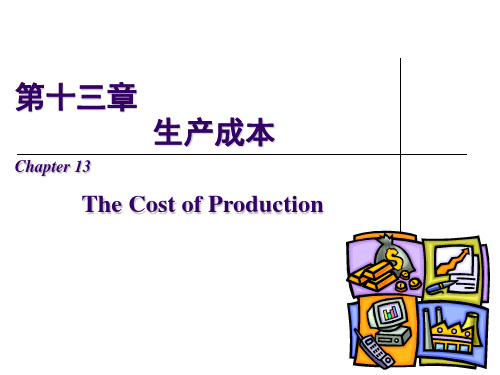
called industrial organization—the study of how firms’ decisions regarding prices
and quantities depend on the market conditions they face. The town in which you live, for instance, may have several pizzerias but only one cable television company. How does this difference in the number of firms affect the prices in these markets
买面粉花了1000美元
糕点工人的工资
海伦放弃程序员工作(100美元/小时)
13.1.3 作为机会成本的资本成本 Costs as Opportunity Costs
资本成本核算
购买糕点厂的方案
economist 动用储蓄30万元 存款利率5% 动用储蓄10万元,贷款20 万元,存贷利率5% accountant
Prologue
In previous chapters we used the supply curve to summarize firms’ production
decisions. According to the law of supply, firms are willing to produce and sell a
投入总成本 (工厂成本+工人成本) (美元) 30 40 50 60 70
5
150
10
30Байду номын сангаас
曼昆《经济学原理》答案
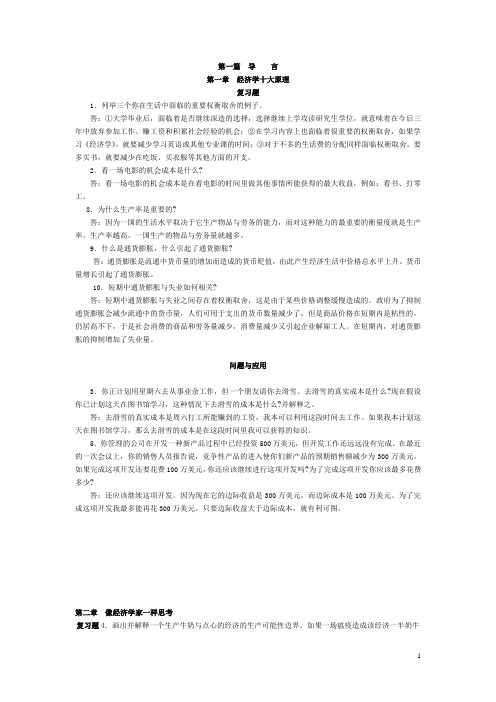
第一篇导言第一章经济学十大原理复习题1.列举三个你在生活中面临的重要权衡取舍的例子。
答:①大学毕业后,面临着是否继续深造的选择,选择继续上学攻读研究生学位,就意味着在今后三年中放弃参加工作、赚工资和积累社会经验的机会;②在学习内容上也面临着很重要的权衡取舍,如果学习《经济学》,就要减少学习英语或其他专业课的时间;③对于不多的生活费的分配同样面临权衡取舍,要多买书,就要减少在吃饭、买衣服等其他方面的开支。
2.看一场电影的机会成本是什么?答:看一场电影的机会成本是在看电影的时间里做其他事情所能获得的最大收益,例如:看书、打零工。
8.为什么生产率是重要的?答:因为一国的生活水平取决于它生产物品与劳务的能力,而对这种能力的最重要的衡量度就是生产率。
生产率越高,一国生产的物品与劳务量就越多。
9.什么是通货膨胀,什么引起了通货膨胀?答:通货膨胀是流通中货币量的增加而造成的货币贬值,由此产生经济生活中价格总水平上升。
货币量增长引起了通货膨胀。
10.短期中通货膨胀与失业如何相关?答:短期中通货膨胀与失业之间存在着权衡取舍,这是由于某些价格调整缓慢造成的。
政府为了抑制通货膨胀会减少流通中的货币量,人们可用于支出的货币数量减少了,但是商品价格在短期内是粘性的,仍居高不下,于是社会消费的商品和劳务量减少,消费量减少又引起企业解雇工人。
在短期内,对通货膨胀的抑制增加了失业量。
问题与应用3.你正计划用星期六去从事业余工作,但一个朋友请你去滑雪。
去滑雪的真实成本是什么?现在假设你已计划这天在图书馆学习,这种情况下去滑雪的成本是什么?并解释之。
答:去滑雪的真实成本是周六打工所能赚到的工资,我本可以利用这段时间去工作。
如果我本计划这天在图书馆学习,那么去滑雪的成本是在这段时间里我可以获得的知识。
5.你管理的公司在开发一种新产品过程中已经投资500万美元,但开发工作还远远没有完成。
在最近的一次会议上,你的销售人员报告说,竞争性产品的进入使你们新产品的预期销售额减少为300万美元。
《经济学原理·曼昆·第三版》第14章

When MR > MC —— increase Q When MR < MC —— decrease Q When MR = MC ——Profit is maximized.
The Marginal-Cost Curve and the Firm’s Supply Decision...
Costs and Revenue
市场上有许多买者和许多卖者
各个卖者提供的物品大体上是相同的
企业可以自由地进入或退出市场
14.1.2 竞争企业的收益 The Revenue Of A Competitive Firm
竞争市场上的企业与经济中大 多数其他企业一样,努力使利 润最大化,利润等于总收益减 总成本。为了说明如何做到这 一点,我们首先考虑竞争企业 的收益。为了使事情具体化, 我们考虑一个特定企业:斯密 的家庭奶牛场。
Costs and Revenue The firm maximizes profit by producing the quantity at which marginal cost equals marginal revenue.
MC
ATC P=MR1 MC1 P = AR = MR AVC
0
Q1
The Firm’s Short-Run Decision to Shut Down
The firm shuts down if the revenue it gets from producing is less than the variable cost of production.
Shut down if TR < VC
14.1 什么是竞争市场 What is A Competitive Market?
